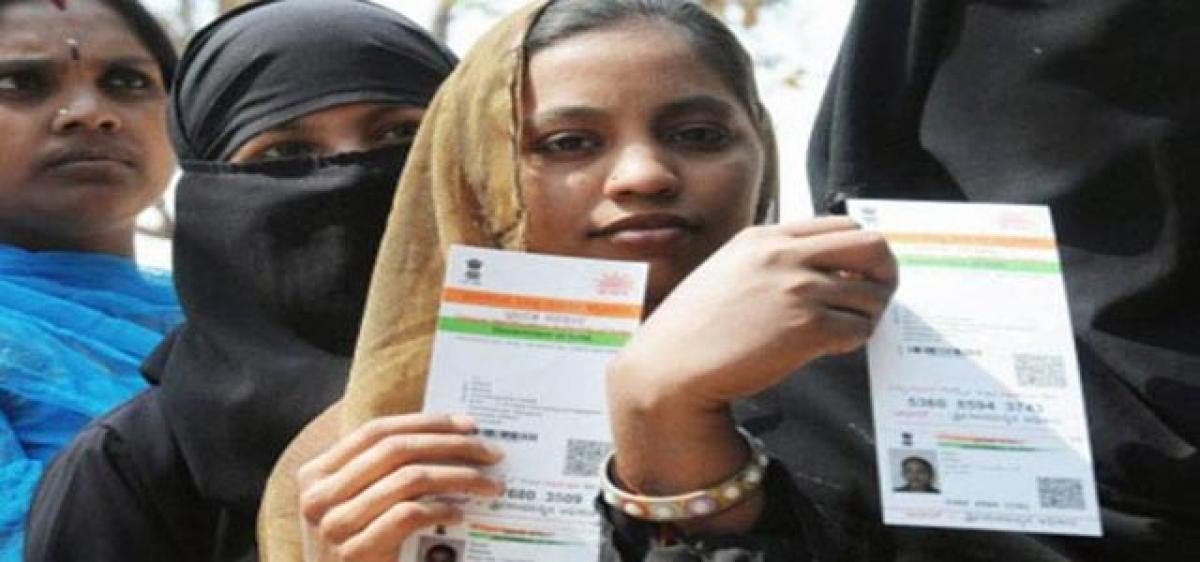Live
- AM Green Kakinada Cluster Joins the World Economic Forum.
- 3 elephants electrocuted in Sambalpur
- Elevate Your Style: Handpicked Luxury Fashion & Accessories
- Ola Electric users continue to cry amid poor service, software glitches nationwide
- Panchayat Raj AE Panduranga Rao caught by ACB while taking a bribe of Rs 50,000.
- Leveraging Data and Analytics for Product Management Excellence: Mahesh Deshpande’s Approach
- Two vegetable varieties of Himachal varsity get national recognition
- Border-Gavaskar Trophy 2023-25: Bowling coach Morne Morkel says Mohammed Siraj is a legend, has a big heart and aggressive mindset
- Michael Vaughan Questions India's Decision to Skip Warm-Up Match Before Border-Gavaskar Trophy
- Rizwan Rested for Final T20I: Agha to Lead Pakistan in Hobart
Just In

More than 1.12 billion Indians - 88.2 per cent of the population - have now been enrolled for Aadhaar, the controversial biometric national identity programme. An analysis of a law that came into effect without much public attention six months ago reveals how the government plans to sign up the remainder of the population.
More than 1.12 billion Indians - 88.2 per cent of the population - have now been enrolled for Aadhaar, the controversial biometric national identity programme. An analysis of a law that came into effect without much public attention six months ago reveals how the government plans to sign up the remainder of the population.
A November 2, 2016, a circular from the Cabinet Secretariat used two sections of the Aadhaar Act of 2016 to make it mandatory for citizens to provide an Aadhaar number to benefit from schemes and services paid for from the Consolidated Fund of India.
The 12-digit, biometric Aadhaar Unique Identification (UID) number, meant to be a voluntary enrolment, will soon be compulsory to receive benefits under 530 welfare schemes and to perform a host of activities including filing income-tax returns, receiving college degrees and obtaining driver’s licenses.
Section 7 of the Aadhaar Act, described as a ‘condition precedent’ in the November circular, allows the Central or the State governments to ask those receiving ‘a benefit, subsidy or service’ from the Consolidated Fund of India to furnish an Aadhaar UID as proof of identity.
The November circular directed all Secretaries to the government to ask Central Ministries and State governments to ‘expeditiously’ identify schemes that can use Aadhaar as ‘primary identification’.
Although the Unique Identification Authority of India (UIDAI), the statutory body collecting Aadhaar data and issuing UID numbers, claims Aadhaar is a voluntary identification option, the programme’s mission statement says Aadhaar is expected to form ‘the basic, universal identity infrastructure’ for ‘registrars, government and other service providers across the country’.
So far, 530 social welfare programmes from 63 Ministries - of nearly 1,200 schemes from 75 Ministries - are ready to be linked to Aadhaar, according to the government's Direct Benefits Transfer (DBT) Mission website.
Started in 2013, DBT is a platform for the government to transfer subsidies and benefits from the Consolidated Fund of India directly into people's bank accounts. The UID programme is expected to play a key role in this.
In February 2017, around 335 million citizens benefited from DBT and roughly 168 million, or 50 per cent, received their welfare funds and subsidies directly through Aadhaar-linked bank accounts, according to this DBT report.
Over 30 per cent of beneficiaries did not receive Aadhaar-linked payments despite holding Aadhaar-linked bank accounts, the report shows. The Act provides for Aadhaar to be the primary identification tool for services that do not use funds from the Consolidated Fund of India, ‘such as issue of SIM cards, KYC (know your customer identification) for opening bank accounts, pension accounts etc.,’ the circular said.
Thus, while not declaring Aadhaar mandatory, these laws ensure individuals using government programmes and services provide Aadhaar as proof of identity or furnish an Aadhaar enrolment slip, or provide a temporary photo identification (such as a driver's license or voter identity card) until they get an Aadhaar UID. If the individual has still not enrolled for the UID programme, the agency concerned may even become a UIDAI registrar to help them do so.
By Alison Saldanha

© 2024 Hyderabad Media House Limited/The Hans India. All rights reserved. Powered by hocalwire.com







